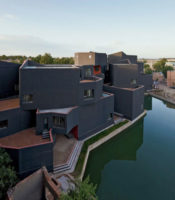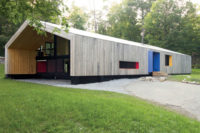Design Vanguard 2009: Min | Day
Madrid

Squeezed onto a small plot of land adjacent to Lake Okoboji, this vacation house maximizes vistas of the lake at every turn while blocking views of neighboring houses. The idea was to create “a series of spatial frames that offer a focused and private experience on an otherwise densely populated shore,” say the architects. On the ground floor, the kitchen and living room flow into a large communal space that expands toward the lake on the other side of a large glazed wall. Above the kitchen, a dramatic skylight ringed with opaque polycarbonate transom panels brings daylight into the heart of the two-story house. While the architects used a mostly white color palette for public spaces, they drenched bedrooms and bathrooms, the most private spaces in the house, in color.
Photo © Paul Crosby

Squeezed onto a small plot of land adjacent to Lake Okoboji, this vacation house maximizes vistas of the lake at every turn while blocking views of neighboring houses. The idea was to create “a series of spatial frames that offer a focused and private experience on an otherwise densely populated shore,” say the architects. On the ground floor, the kitchen and living room flow into a large communal space that expands toward the lake on the other side of a large glazed wall. Above the kitchen, a dramatic skylight ringed with opaque polycarbonate transom panels brings daylight into the heart of the two-story house. While the architects used a mostly white color palette for public spaces, they drenched bedrooms and bathrooms, the most private spaces in the house, in color.
Photo © Paul Crosby

Squeezed onto a small plot of land adjacent to Lake Okoboji, this vacation house maximizes vistas of the lake at every turn while blocking views of neighboring houses. The idea was to create “a series of spatial frames that offer a focused and private experience on an otherwise densely populated shore,” say the architects. On the ground floor, the kitchen and living room flow into a large communal space that expands toward the lake on the other side of a large glazed wall. Above the kitchen, a dramatic skylight ringed with opaque polycarbonate transom panels brings daylight into the heart of the two-story house. While the architects used a mostly white color palette for public spaces, they drenched bedrooms and bathrooms, the most private spaces in the house, in color.
Photo © Paul Crosby

Squeezed onto a small plot of land adjacent to Lake Okoboji, this vacation house maximizes vistas of the lake at every turn while blocking views of neighboring houses. The idea was to create “a series of spatial frames that offer a focused and private experience on an otherwise densely populated shore,” say the architects. On the ground floor, the kitchen and living room flow into a large communal space that expands toward the lake on the other side of a large glazed wall. Above the kitchen, a dramatic skylight ringed with opaque polycarbonate transom panels brings daylight into the heart of the two-story house. While the architects used a mostly white color palette for public spaces, they drenched bedrooms and bathrooms, the most private spaces in the house, in color.
Photo © Paul Crosby

Squeezed onto a small plot of land adjacent to Lake Okoboji, this vacation house maximizes vistas of the lake at every turn while blocking views of neighboring houses. The idea was to create “a series of spatial frames that offer a focused and private experience on an otherwise densely populated shore,” say the architects. On the ground floor, the kitchen and living room flow into a large communal space that expands toward the lake on the other side of a large glazed wall. Above the kitchen, a dramatic skylight ringed with opaque polycarbonate transom panels brings daylight into the heart of the two-story house. While the architects used a mostly white color palette for public spaces, they drenched bedrooms and bathrooms, the most private spaces in the house, in color.
Photo © Paul Crosby

For an organization founded in 1981 by artists, Min | Day did not want to create a static container for art, but rather a transmutable landscape within which art occurs. Their plan for the Bemis Center — designed in collaboration with FACT (Fabrication And Construction Team) — stems from the ideology of contemporary art practice, which increasingly repudiates objecthood and fixed reference in favor of art that is open to many meanings and experiences. In addition to the landscape-driven master plan, Min | Day proposed a design for the Okada Ceramics & Sculpture Facility, which will contain a studio space with kilns, a ceramics archive, and a large performance space.
Image courtesy Min | Day

For an organization founded in 1981 by artists, Min | Day did not want to create a static container for art, but rather a transmutable landscape within which art occurs. Their plan for the Bemis Center — designed in collaboration with FACT (Fabrication And Construction Team) — stems from the ideology of contemporary art practice, which increasingly repudiates objecthood and fixed reference in favor of art that is open to many meanings and experiences. In addition to the landscape-driven master plan, Min | Day proposed a design for the Okada Ceramics & Sculpture Facility, which will contain a studio space with kilns, a ceramics archive, and a large performance space.
Image courtesy Min | Day

For an organization founded in 1981 by artists, Min | Day did not want to create a static container for art, but rather a transmutable landscape within which art occurs. Their plan for the Bemis Center — designed in collaboration with FACT (Fabrication And Construction Team) — stems from the ideology of contemporary art practice, which increasingly repudiates objecthood and fixed reference in favor of art that is open to many meanings and experiences. In addition to the landscape-driven master plan, Min | Day proposed a design for the Okada Ceramics & Sculpture Facility, which will contain a studio space with kilns, a ceramics archive, and a large performance space.
Rendering courtesy Min | Day

In collaboration with artists Leslie Iwai and Jamie Burmeister, Min | Day designed the surface treatment for a 1,000-foot-long and 18-foot-high retaining wall that runs along a flood-control plain between a park and the University of Nebraska. The team developed a system of stainless-steel tiles that will reflect changes in the sky, floodwater levels, and activity in the park. Inspired by the work of mathematician Roger Penrose, Min | Day devised a system that uses tiles of only two shapes to create a pattern that has a five-fold rotational symmetry but never repeats.
Rendering courtesy Min | Day

In collaboration with artists Leslie Iwai and Jamie Burmeister, Min | Day designed the surface treatment for a 1,000-foot-long and 18-foot-high retaining wall that runs along a flood-control plain between a park and the University of Nebraska. The team developed a system of stainless-steel tiles that will reflect changes in the sky, floodwater levels, and activity in the park. Inspired by the work of mathematician Roger Penrose, Min | Day devised a system that uses tiles of only two shapes to create a pattern that has a five-fold rotational symmetry but never repeats.
Rendering courtesy Min | Day

Part of a Slow Food Nation 2008 event, the Spirits Pavilion explored the emerging practices of sustainability and craftsmanship in today’s spirits industry. Min | Day designed an environment for sampling cocktails that alludes to the alchemical transformation of agricultural sources (such as grapes) into refined products (such as brandy). Colored strips on the floor and walls represent base spirits — whiskey, brandy, rum, vodka, gin, and tequila — and the ingredients they’re made from. Paper parasols reminiscent of cocktail umbrellas and clouds add a playful touch and help soften the lighting.
Photo © Cesar Rubio

Part of a Slow Food Nation 2008 event, the Spirits Pavilion explored the emerging practices of sustainability and craftsmanship in today’s spirits industry. Min | Day designed an environment for sampling cocktails that alludes to the alchemical transformation of agricultural sources (such as grapes) into refined products (such as brandy). Colored strips on the floor and walls represent base spirits — whiskey, brandy, rum, vodka, gin, and tequila — and the ingredients they’re made from. Paper parasols reminiscent of cocktail umbrellas and clouds add a playful touch and help soften the lighting.
Photo © Cesar Rubio

In 2003, Min | Day and FACT, a student-staffed design lab led by Jeff Day, began a long-term working relationship with Art Farm, a rural artist-in-residence program in Marquette. The architectural team designed an organizational infrastructure for an expansion of Art Farm over the next 10 years and renovations for salvaged structures that have been moved to the site from other farming communities. The most prominent public space will be the Red Barn Gallery, a salvaged structure with a modern white-walled interior that will display works produced by the Art Farm residents. The architects explain that their design “represents the juxtaposition of the vernacular, place-bound physicality with the abstraction of universal ‘white cube’ art-gallery space.”
Rendering courtesy Min | Day

In 2003, Min | Day and FACT, a student-staffed design lab led by Jeff Day, began a long-term working relationship with Art Farm, a rural artist-in-residence program in Marquette. The architectural team designed an organizational infrastructure for an expansion of Art Farm over the next 10 years and renovations for salvaged structures that have been moved to the site from other farming communities. The most prominent public space will be the Red Barn Gallery, a salvaged structure with a modern white-walled interior that will display works produced by the Art Farm residents. The architects explain that their design “represents the juxtaposition of the vernacular, place-bound physicality with the abstraction of universal ‘white cube’ art-gallery space.”
Image courtesy Min | Day














Architects & Firms
Since starting their firm in 2003, Jeffrey Day and E.B. Min have operated in two worlds—the hilly streets of San Francisco and the flat plains of Nebraska. The origins of Min | Day date back to the early 1990s at the University of California, Berkeley, where both partners went to graduate school and shared a love of conceptual art. While working in the Bay Area, the two considered starting their own firm, but the timing didn’t seem quite right. Only when Day decided to move to Nebraska with his fiancée and take a teaching position at the University of Nebraska did their talks get more serious. “Most people thought we were crazy to start a firm right when Jeff was leaving for Nebraska,” says Min, who stayed in the Bay Area. “But we thought that unexpected opportunities might arise out there.”
Over the past six years, their unorthodox move has proved to be one of the firm’s largest assets. “A lot of people think that architecture only happens on the coasts,” says Day, “but we actually do some of our most experimental work in the Midwest.” A good example is a master plan and renovated barn shed they designed for Art Farm, an artist community in Marquette, Nebraska. “There is a lot of romanticism attached to the image of the barn, but we weren’t into that,” remarks Day. “Farmers repurpose barns all the time, so we had no hesitation cutting into the structure and inserting something entirely new.” The architects resurrected the 100-year-old weathered building by inserting a curving, digitally fabricated foam interior where visitors can recline and watch video installations by Art Farm residents.
For Art Farm and other clients with marginal profits, Min | Day often works with its allied practice FACT (Fabrication And Construction Team), a group affiliated with the University of Nebraska’s architecture school and staffed by students, research assistants, and paid interns.
While Min and Day work with a wide variety of clients and at a range of scales, their projects consistently reveal their detail-driven process and technological savvy. For a vacation house on Lake Okoboji in Iowa, a rippling CNC-milled headboard in the master bedroom mimics the nearby lake surface, and the kitchen is filled with custom-designed furnishings. In an Omaha condominium, light filters through digitally fabricated screens designed to look like prairie grass—a nod to the natural world beyond the project’s walls.
Throughout the two architects’ careers, nature and landscape has seeped into their work. “When I visit Omaha, I love seeing how the landscape changes from rolling hills to foothills to flat farmland,” says Min. “It just keeps your eyes fresh.” Min’s infatuation with nature started when she worked at San Francisco—based Andrea Cochran Landscape Architecture. “In landscape architecture, you deal with color all the time,” continues Min. “Seeing how it was used in landscape opened my eyes to using it in architecture.”
Vivid shades emanate from much of their work. Color serves as an accent in one project, envelops an entire room in the next, and is completely absent in another. But color is not the defining theme of their practice. “We’re not trying to apply a theoretical idea about color when we go into a project,” says Day. “Our work always stems from the conditions we’re dealing with, not a preconceived framework.”
Given the current state of the economy, the firm continues to experiment, but on smaller scales. Recently, it has dabbled in furniture design and created floor plans for Hometta.com, a Web site that sells house plans online. Even though work is slowing down, Min and Day remain hopeful about the future of their firm. “I could see our work looking very different in the next 10 years because we don’t have a stylistic agenda,” says Day. “We’re all about improvising with the conditions at hand and creatively tackling any problems that arise.”





